Expert’s Rating
Pros
- Solid hardware
- Great value for wireless
- Tons of customization options
Cons
- No wrist rest
- slightly awkward default layout
Our Verdict
The K65 Plus Wireless is up against stiff competition in its segment, but it edges out great keyboards like the BlackWidow 75% with its excellent all-around hardware and superior value.
Price When Reviewed
Corsair K65 Plus Wireless keyboard: $159.99
Corsair K65 Plus Wireless keyboard: $159.99
The segment of high-end, customizable, 75% mechanical gaming keyboards is about as niche as it gets for products from major companies. It’s also, as my grandfather used to say, hotter than a two-dollar pistol. Razer, Alienware, and Asus have all released competitors within the last year, and I know HP (by way of subsidiary HyperX) is itching to join the fray, to say nothing of more boutique offerings from the likes of Glorious and Keychron. Today Corsair is piling on with its newest K65 variant.
After the huge improvements Corsair made to a basic design with the K70 Core, I was excited to see what the company would bring to a more premium offering. And the K65 Plus Wireless does not disappoint. This little keyboard includes everything you want in this category and nothing you don’t. Add to that a competitive price and competent software, and Corsair instantly makes its way towards the top of a short but intensely contested list.
If you want a wireless, gaming, 75% custom keyboard, this is it. If wireless isn’t important to you…well, there’s one other option you should consider.
Further reading: The best wireless gaming keyboards
Corsair K65 Plus Wireless design and layout
The K65 Plus Wireless (which I’m just going to call the K65 for the remainder of this review) will look familiar to anyone who’s been keeping up with this space. Like the Razer BlackWidow V4 Pro 75 or the Alienware Pro Wireless, it’s a 75% layout that squeezes a bit of the bottom right corner in order to accommodate full-sized arrow keys, but otherwise works with standard keycaps. This seems to be the new “it” form factor for gaming, cutting into both 60% and TKL designs. As is becoming standard, you can choose between triple-device Bluetooth, a 2.4GHz wireless dongle, or wired operation.
If you want a wireless, gaming, 75% custom keyboard, this is it.
Michael Crider/Foundry
The keyboard has all the usual bells and whistles, eschewing only exotic options like a mini display or adjustable actuation (as seen in Corsair’s K70 Max). We’re talking hot-swap switch sockets, full RGB support, and an aluminum volume knob. The keycaps, in professionally muted blue-gray hues with a bit of extra trim on the space bar, are high-quality PBT with dye-sublimated legends that will never fade. Below the surface you get a heavy steel plate (which oddly contrasts with the plastic body), internal foam and silicone dampening, and a massive 4,200mAh battery.
There’s a surprising amount going on at the edges of the K65, too. On top you get the usual USB-C charging port, a storage bay for the dongle, a three-way power/Bluetooth/2.4GHz wireless switch, and a dedicated Win/Mac layout switch. That’s something you don’t often see on keyboards marketed for gaming, but you’ll note that the default keycaps also have Mac sub-legends, so why not? On the left side you get something I haven’t seen on other designs: a dedicated lighting button. This will instantly switch your lights on or off (not counting the status lights), regardless of your other settings or programmed lighting patterns. It’s a great little addition.

Michael Crider/Foundry
The bottom of the keyboard has the standard double-stage keyboard feet and a fetching Corsair triangular pattern. The box includes a keycap/switch puller, the dongle, a charging/data cable…and that’s it. Those ellipses were me looking for a wrist rest, but unfortunately it’s not in there.
In terms of aesthetics, the K65 is good, not great. The plastic case and busy keycap legends lack the understated style of Alienware’s dazzling all-white or all-black boards. The faux metal paint of the Corsair-branded escape key is a bit of a disappointment, though it does nicely balance the radial dial. And the RGB lights, while smoothly animated and offering tons of customization, aren’t anywhere near as flashy as alternatives like the Roccat Vulcan series. This is, in many ways, a button-down design by the standards of both Corsair and the gaming keyboard market as a whole.
What’s it like to type and game on the K65 Plus Wireless?
The K65 is using the same high-quality, pre-lubed Corsair MLX Red switches as the K70 Core, and they’re just as good here. The sound is a little louder — I imagine that’s because of the thick steel plate between the switches. Underneath is foam between the plate and printed circuit board, and a unique, custom silicone pad between the PCB and the plastic case. Typing is smooth and light, if somewhat longer than other boards, and a little shaky thanks to a standard cross stem without an outer reinforcement. Stabilizers are solid, not spectacular, with a bit of rattle in the space bar.
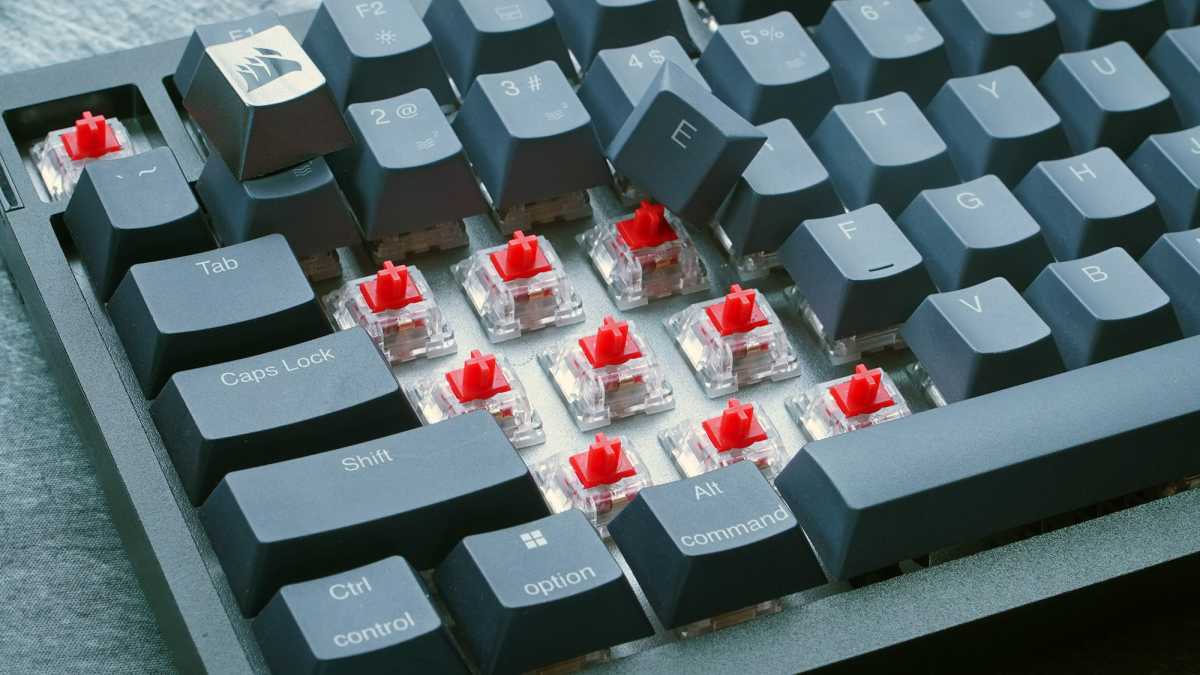
Michael Crider/Foundry
A 75% layout requires a bit of compromise no matter how you slice it, and I don’t think I’m a fan of the Delete key moved to the top row when my muscle memory has it to the right of the \ key. The default function layer also has some odd choices, like putting Print Screen on the “?” key. These are minor quibbles that can be adjusted with software, and there are some smart choices in the default layout, too. For example, Fn+the arrow keys will let you quickly make the radial dial set to adjust volume, scrolling, zooming, or keyboard lighting. That’s some impressive utility without any tweaking from the user.
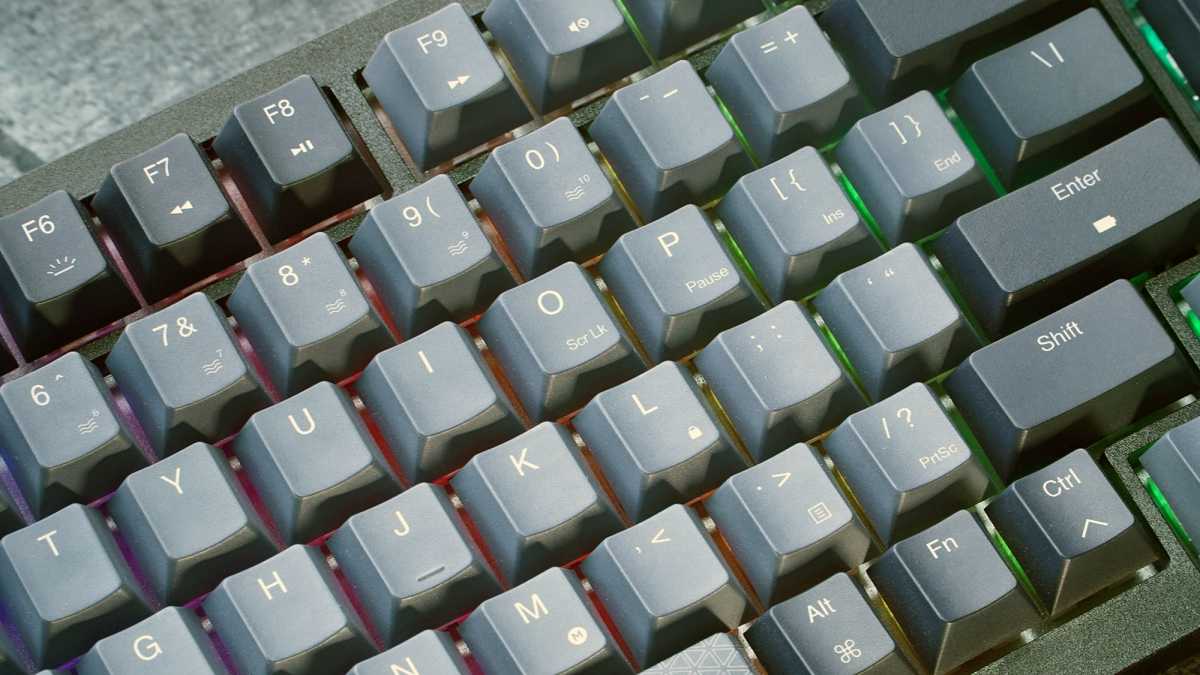
Michael Crider/Foundry
Gaming is even better. While the keyboard lacks any of the crazy speed of some more recent models (it tops out at 1,000Hz polling in both wired and dongle wireless modes), that’s more than enough if you’re a mere mortal. The keycaps are comfy with a solid but not grainy texture, and the 45 grams of resistance is the sweet spot for a wide variety of game types. While they’re very good, I’m not quite as enamored with Razer’s custom MLX switches as Dell’s custom Red switches on the Alienware Pro Wireless or Razer’s Gen 3 switches with their gigantic, super-stable stems. But like all the keyboards in this category, you’re more than welcome to swap them out for something more premium. And on that note…
Customization and software on the K65 Plus Wireless
The K65 invites customization for its switches and keycaps, the latter only diverging from a standard TKL layout with a shortened right Shift key and modifiers. This is easy to adjust for, and plenty of kits come with extra caps specifically for this layout. It has an identical number of keys to the BlackWidow V4 75% and the Keychron Q1, for example. Switches are standard two-pin Cherry MX-compatible, though oddly the ones in this case don’t come with stabilizer pegs. Don’t worry, the PCB has holes to accommodate them, so it can handle whatever exotic switches you care to throw at it. Corsair would suggest the Holy Panda X from its new subsidiary Drop…but at more than $1 each, I’d go for something a little less spendy.
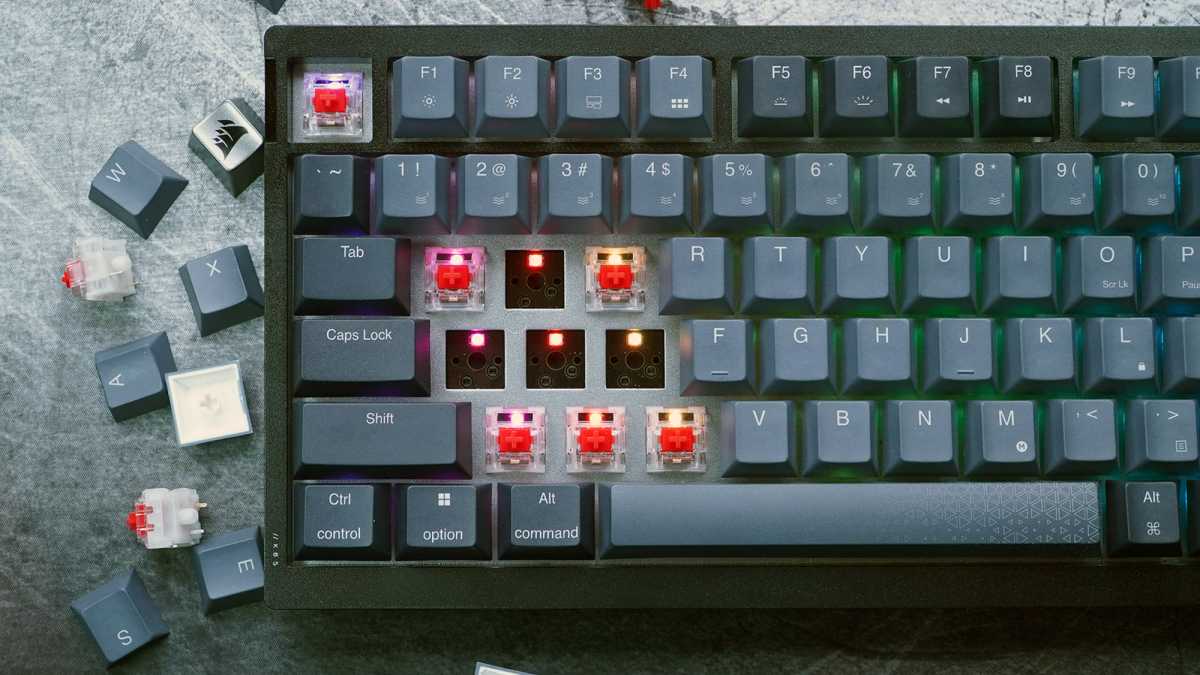
Michael Crider/Foundry
What about other mods? The K65’s plastic case doesn’t exactly invite you inside like Keychron boards do with their tools in the box. But with nothing but a standard Philips head and a little patience, and maybe an organizer for the many screws, you can get the thing apart and access the guts. (Take particular note of that big, custom silicone pad, nice!) More advanced modifications, like upgrading the stabilizers or the popular “tape mod,” are easy enough for anyone with a bit of know-how. The only real danger is in breaking the standard battery wire.
I love the ability to set a custom wireless timeout to optimize battery saving or instant-on convenience.
Like Razer with its BlackWidow V4 75%, Corsair’s warranty does not cover user modifications of any kind, and even disassembly is a no-no. Unlike Razer, Corsair doesn’t actually promote the K65 with any mention of this kind of customization. And as far as I can see, there are no telltale stickers or seals that will get you an automatic warranty denial just for taking a look inside. That’s a small win for Corsair, if only for a slightly more honest marketing approach.
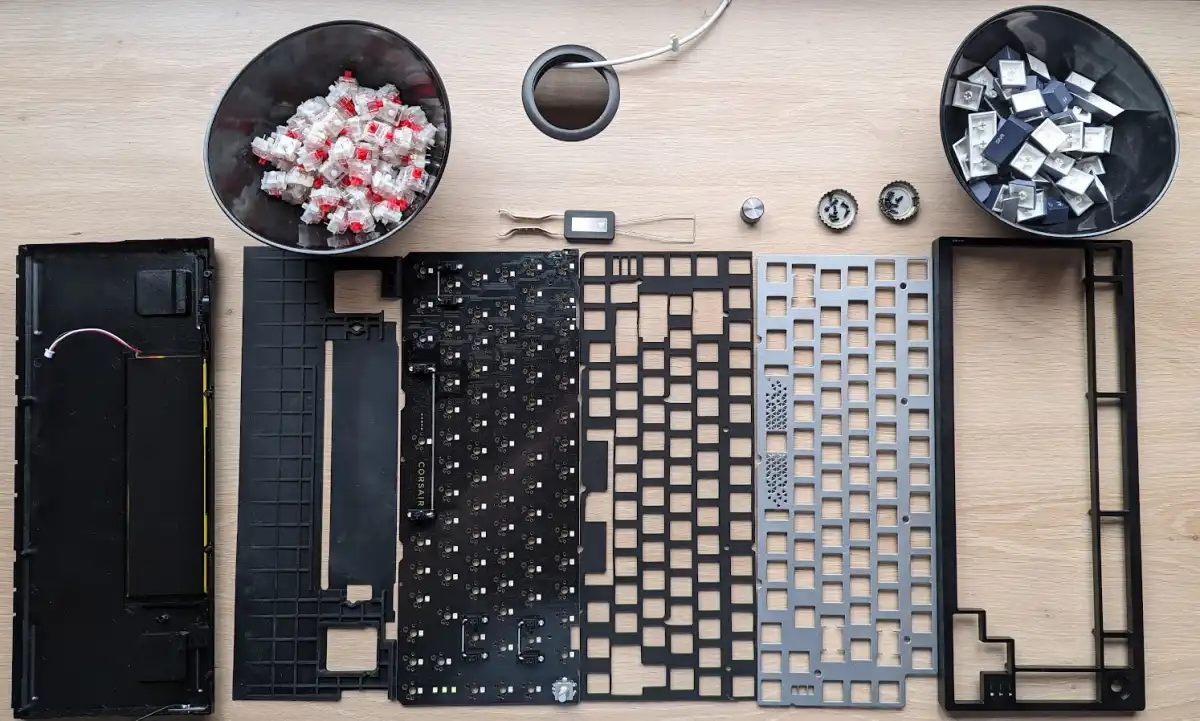
Pictured: a plastic case, a layer of silicone, a PCB, a layer of foam, a steel plate, one knob, 18 screws, 18 switches, 18 keycaps, and one voided warranty.
Michael Crider/Foundry
Corsair’s iCue software remains one of the better gaming driver packages, though I stress that this is not a high bar to clear. Assigning custom keystrokes and macros is straightforward, and navigating the various options for lighting and performance is natural without any unnecessary flash. I love the ability to set a custom wireless timeout to optimize battery saving or instant-on convenience, and Corsair remains the only company I’ve seen with a dedicated “PlayStation Mode” toggle for console gamers. Very thoughtful.
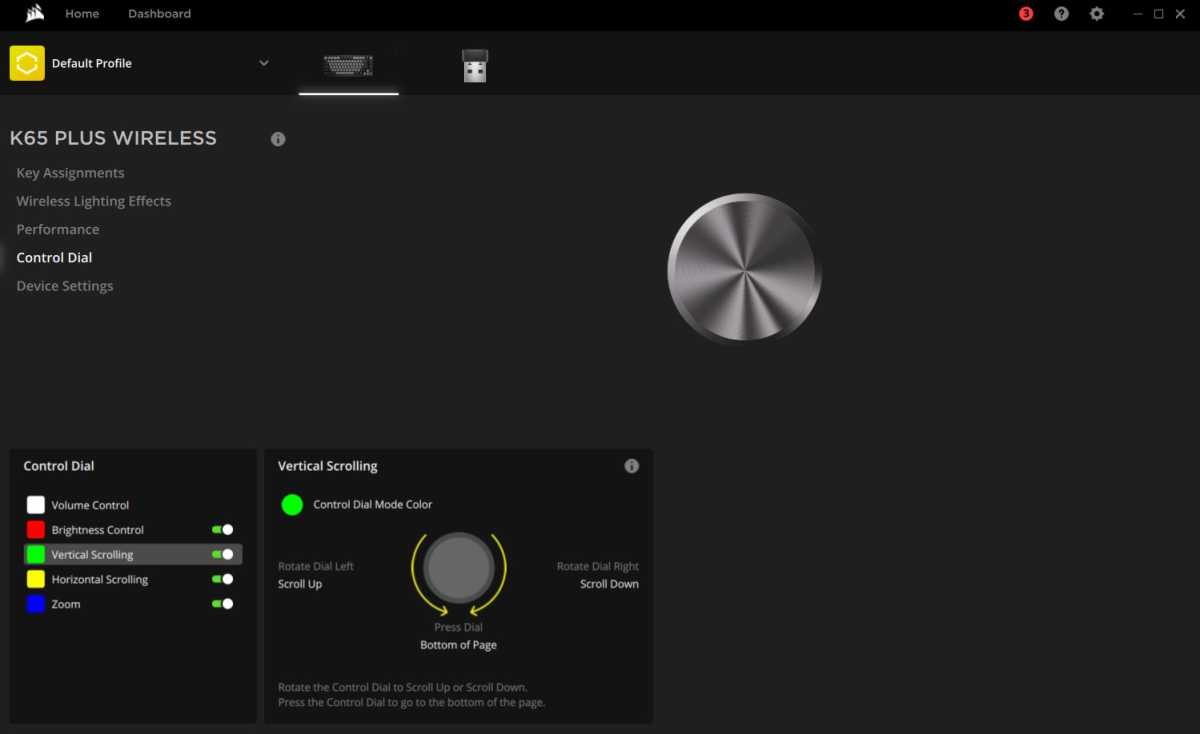
Corsair
The dedicated section for the radial dial is a nice choice, though it’s a bit limited. You can’t, for example, set a right turn to A and a left turn to D. In fairness, I can’t imagine why you’d want to — the default options cover every practical use. Strangely, setting the different control modes flashes the status LED, all the way over on the left side of the keyboard, to indicate its mode. A light under or around the knob would be much more intuitive here.
How does the K65 Plus Wireless compare to the competition?
Here’s where Corsair earns big points versus the competition in this category. Let’s compare the K65 with the Alienware Pro Wireless and the Razer BlackWidow V4 75%. (The Asus ROG Azoth is just too expensive, and its awful software knocks it off the shortlist.) Comparing apples to apples, the K65 has the same wireless powers as the Alienware, minus its lovely curvy body but plus a volume dial. Call it a wash on the hardware…but at $160, the Corsair board is $40 cheaper, and iCue is leagues better than AlienFX. The K65 wins hands down.
Pitting Corsair against its rival Razer is a little more complex. Razer includes an excellent comfy wrist rest with the BlackWidow, something I have to respect. I also think its dial + media buttons control setup has an edge in usability, and I like its all-black aesthetics over the mix of colors and materials on the K65. Razer also wins with better custom switches and “thockier” typing, though not by much, and better software, again, not by much. Razer still uses ABS plastic on its BlackWidow boards, making you pay for an upgrade. Boo, hiss, et cetera.
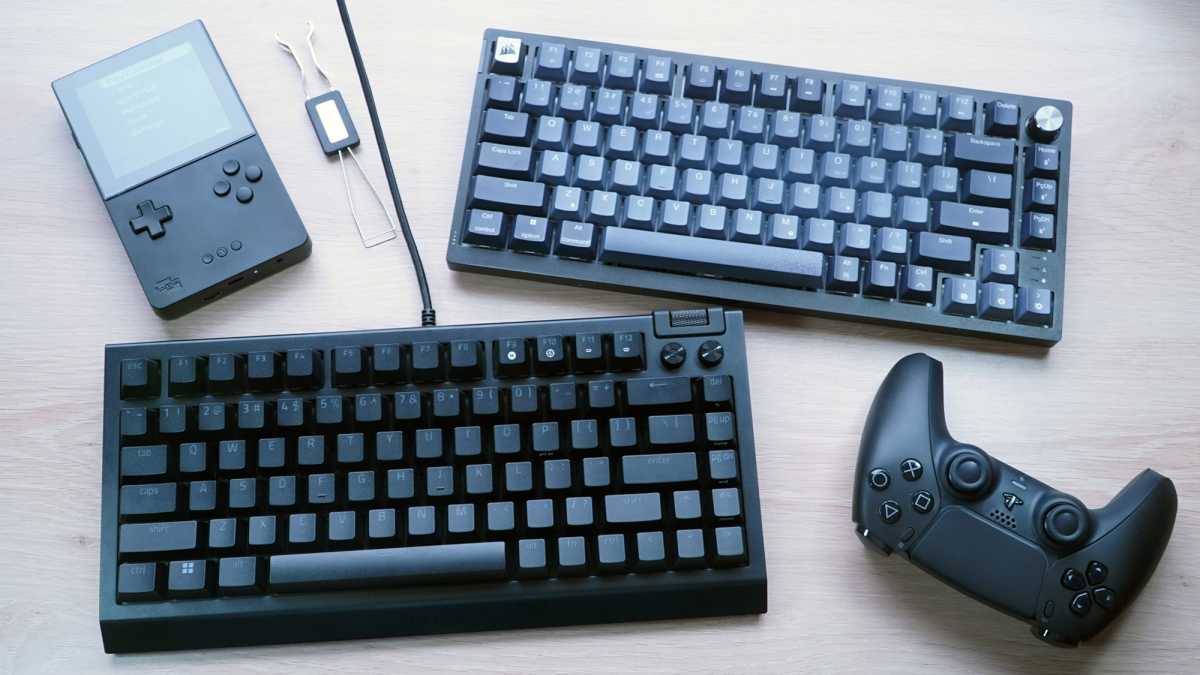
Michael Crider/Foundry
I’d say that the BlackWidow is a better all-around package, if it weren’t for the fact that Razer dropped wireless options when it went from the V3 to the V4 series. Between that, and the $30 price difference, the Corsair K65’s better capability and value give it the win by a nose. Razer might still be a better call if you value that oh-so-smooth typing feel out of the box. But for my desk, I’d buy the K65 and a wrist rest (this one, specifically!) and pocket the difference, then look out for some fun keycaps and switches down the road.
The K65 Plus Wireless is in an incredibly tough category. But with Corsair’s much-improved keyboard and design, some thoughtful touches for the layout, and wireless capability at a better price than the alternatives, it comes out ahead. It’s the best all-around gaming keyboard on the market in early 2024.



